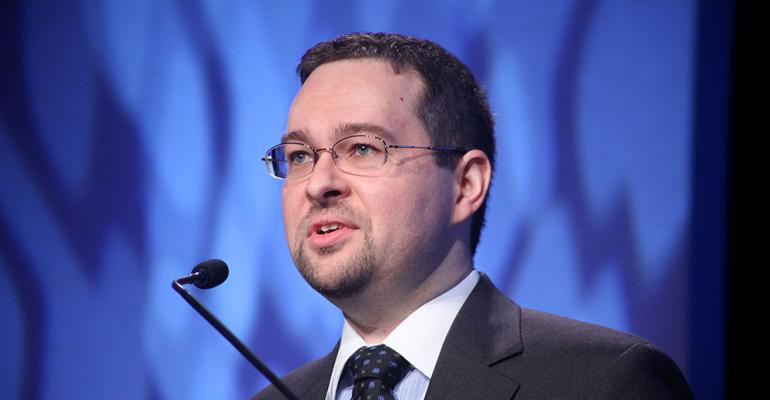TRAVERSE CITY, MI – Vehicle sales are increasing, but economist Steven Szakaly sees a roadblock ahead erected by the EPA.
The agency’s ambitious and escalating fuel-economy mandates in coming years carry “huge implications” for the auto industry, says the chief economist for the National Automobile Dealers Assn.
“It is hard to see a successful way for the industry to avoid significant losses or a decline in sales,” he says at the Management Briefing Seminars here.
The EPA has set a CAFE target of 54.5 mpg (4.3L/100 km) by 2025. That would require automakers to sell smaller cars, make high-volume vehicles more fuel efficient and offer more electric vehicles.
Szakaly questions whether the public will vote for that with their dollars.
“It is tough to see consumers paying $3,000 more for the same car just because someone in Washington says you have to buy it,” he says.
Many automakers already offer EVs in an attempt to meet government regulations but they’re often sold at a loss. Fiat Chrysler Automobiles CEO Sergio Marchionne complains the company loses $14,000 on every Fiat 500e it sells in limited markets, such as California.
Meeting ambitious CAFE targets means automakers must equip cars with advanced technologies that add to vehicle costs. NADA fears that may price many consumers out of the market.
“It would also reduce their choice of vehicles,” Szakaly tells WardsAuto. “NADA supports improved fuel economy, however, not at the cost of significantly higher prices, reduced sales and fewer types of vehicles to choose from.”
Today, though, things are looking pretty good, he says.
Low auto-loan rates (although they’ve bumped up a bit), rising home values and an improving employment outlook contribute to a resurgence in new-vehicle sales, Szakaly says.
“There is no sign that these fundamental drivers will change this year,” he says.
“Many consumers have delayed making a new-car purchase. And with the improving economy, they are now looking at trading up their cars for something newer.”
He forecasts new-vehicle sales of 16.4 million this year, a 5.8% increase from 2013. He foresees sales of 16.7 million units in the U.S. in 2015.
“We’ve had an agonizingly slow recovery that has in many ways been led by the automotive sector, but the overall economy is finally picking up,” he says, citing factors that include relatively stable gasoline prices.
“Auto sales are affected when people are not sure what it will cost to operate their vehicles,” he says. “So, stable auto prices are important.”
He points to shifting consumer trends that may affect new-vehicle demand.
Traditionally, much of life in America centered on single-family housing and relatively long commutes. “That’s changed, but not completely,” he says. “We are seeing some shifts.”
Those include people living in multiple-family housing, living closer to work, working from home and using public transportation slightly more.
That results in fewer miles driven, which in turn reduces the cycle of car-buying because people keep their cars longer.
Today’s consumers are rational car buyers, Szakaly says. “They do a lot of research, know what they want to pay and don’t want to go beyond that. They’ve done a cost analysis. Maybe not on an Excel spreadsheet, but they’ve done it.”
Because of online research and shopping, car buyers physically visit fewer dealerships today, an average of 2.5, he says. “Most walk into the store without having previously contacted the dealerships. Millennials are different. Two out of three of them contact the dealership before their visit.”
The Internet helps consumers wade through the large number of vehicles on the market. That includes 29 midsize sedans, alone. “No way can cross-shoppers get in every vehicle,” Szakaly says.
Consumers tend to take out loans for about half the time they expect to own a car, he says. “Again, that’s a rational decision.”
The auto-financing industry is in good shape, even though some people see a risk in longer loan terms. But the industry needn’t fear a lending bubble, says Itay Michaeli, director of Citi Investment Research and Analysis.
“Longer-term loans are because many people are keeping their cars longer,” he says. “But delinquencies and charge-offs are at record lows, and monthly payments are up.”





